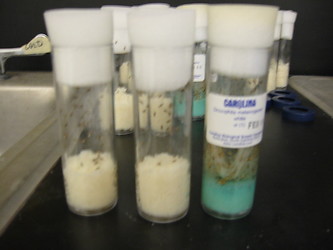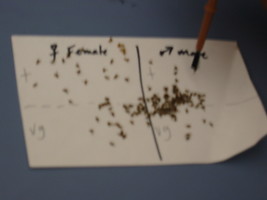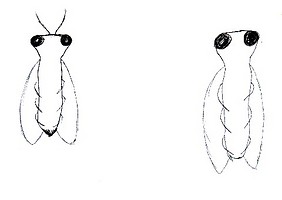Introduction
This particular project was focused on the genetic mutations of eye color and wing type. Because of the testing amounts and time restrictions, we needed a "guinea pig" that would reproduce fairly quickly, could be easily disposed of (Rabbits = bad idea) and could be easily identified to their Phenotypes because of their simple genetic makeup. At the beginning of the experiment, we started with two vials. Vial 1 contained white females and wild males, six of each. Vial 2 contained wild females and white male, six of each.
Drosophila Melanogaster Classification
Kingdom: Animalia
Phylum: Arthropod (body segments have appendages, exoskeleton)
Class: insecta (head, thorax, abdomen)
Order: Diptera (one pair of wings, sucking piercing or lapping mouth parts)
Genus: Drosophila
Species: melangaster
Phenotypes Studied
In this experiment we have three different types of flies: Wild, Vestigial Wing, and White Eye. Wild characteristics are average, non-mutated species, namely, red eyes and full, folded wings. Vestigial wings are a mutation where the wings don't develop properly and are shriveled and deformed. The white eye mutation causes the wild red eye of the fly to become a lighter color that is more of and off-white or tan than true white.
The two we will be using are Wild eye (represented by a +) and White eye (represented by a w).
Group Life Cycle Log
| Date | Entry |
| 2/27 | Flies are expanded to new cultures |
| 3/2 | No sign of larvae. Medium dry; added water. |
| 3/3 | Larvae in early stages, burrowing and eating |
| 3/6 | Larvae have grown and some progressed to pupae stage. |
| 3/7 | No noticeable growth in larvae. number of pupae increased to 20,. 15 new adult flies. |
| 3/9 | Close to 30 flies. Equal larvae and pupae. None hatching, Few adult flies dead. |
| 3/10 | Pupae almost done hatching. Almost all Larvae progressed |
| 3/16 | Start of main experiment. Our group has our own fruitflies. Chosen 6 male+ to be bred with 6 femalew (vial 1); also 6 malew to be bred with 6 female+(vial 2). Ready to begin P1 Cross. |
| 3/17 | No noticeable signs of larvae. 2 male, deceased. Flies appear edgy. |
| 3/20 | Still no signs of larvae. 4 malew deceased. Believe medium is too dry; going to add more water to both vials |
| 3/21 | Vial 1 has signs of larval activity. 4 currently seen, maybe more in center of medium. No signs of larvae in vial 2. No new deaths. |
| 3/23 | Larvae in vial 1 have progressed to pupae stage. Vial two has gained new larvae. Euthanized adult flies. |
| 3/24 | Last of vial 1 larvae going into pupae stage. Vial 2 has gained new pupae. |
| 3/27 | Vial 1 : Newly hatched flies. Most of them are wild eye. Still a lot of pupae to hatch. Vial 2 : One hatched fly. A few pupae ready to hatch. Ground looks dry & broken up; probable cause is larvae burrowing. |
| 3/28 | Vial 1 : Many flies have hatched. Few pupae close to hatching. Vial 2 : Number of flies has nearly doubled. |
| 3/30 | Vial 1 : Almost all flies have hatched; many of which are wild eye, few white eyed. Approx. 20 more pupae to hatch. Vial 2 : One pupa left to hatch. One fly is white eyed while the others are wild eye. |
| 4/3 | Time to begin F2 cross. Unfortunately, it appears our F1 flies were contaminated. Due to this only our male flies for planned crosses are useable. To remedy this, we have obtained female flies from a group that is very similar to ours. We have transferred them to their new vial's and have cleared the rest. |
| 4/17 | Vial 1 : Medium starting to dry out. Most flies dead, only a few live specimens. Vial 2 : No flies. A pink dome in the center of the vial. It almost looks like pink cottage cheese, or a very small brain. We believe it to be an extreme bacterial infection. We have no choice but to dispose of it. |
| 4/21 | Vial 1 : Few flies hatched from pupae. It appears that not many larvae survived. |
| 4/24 | Vial 1 : 2 flies, both white eye. One escapes the other is male. |
Sexing the Flies
During this time of sexing the flies we had to do the following:
1.Take both vials of flies and tap the bottom downwards
2.Prepare fly nap by dipping the black Q-TIP looking object into small bottle of fly nap
3.Tap the bottom of the vials downwards and quickly pinch the foam in the vial allowing enough room for the Q-TIP like object to slide in easily (TRY NOT TO TOUCH FLY NAP TO THE VIAL OR THE FOAM).
4.Wait about 3 to 4 minutes for all of the flys to fall to the bottom of the vail and then they are ready to be poured out on to a 3x5 note card divided saying on one side male and the other female
5.Once scattered on the 3x5 note card flip over flies to reveal there stomachs to the sky.
6.The males often have a slightly larger dot on the bottom of the abdomen; the females do not. (This is harder to tell on newly hatched adults)
7. Then place the females on the female side and the males on the male side.
F1 Predictions
If the mutation for white is sex-linked recessive, and wild is dominant,
Then the genotypes will be…
Female Mutation:
50% XwX+
50% XwY
Male Mutation:
50% XwX+
50% XwY
Here is a Punnet square showing a cross between a white-eyed female and a wild-eyed male. (Sex-Linked white-eye Recessive, as in the Hypothesis.)
| X+ | Y | |
| Xw | Xw X+ | Xw Y |
| Xw | Xw X+ | Xw Y |
Here is the same square, but this time the cross is between a white-eyed male, and a wild-eyed female:
| Xw | Y | |
| X+ | Xw X+ | X+ Y |
| Xt | Xw X+ | X+ Y |
F1 Outcomes
Vial 1 cross: White eye Female X Wild eye Male
Male Phenotype: White eye
Likely Genotype: XwY
Female Phenotype: Wild eye
Likely Genotype: X+Xw
Vial 2 cross: Wild eye Female X White eye Male
Male Phenotype: Wild eye
Likely Genotype:X+Y
Female Phenotype: Wild eye
Likely Genotype:X+Xw
We have determined the genotype based on the supported guess that our variant phenotype is sex-linked recessive.
F2 Predictions
Our hypothesis about our mutation was that it was sex linked recessive.
vial 1 f1 cross=male w genotype = XwY X female, geno= XwX+
| Xw | Y | |
| Xw | XwXw | XwY |
| X+ | X+Xw | X+Y |
%Phenotypes in f2
25% white eyes homozygous female
25% wild eyes heterozygous female
25% white eyes male
25% wild eyes male
%Genotypes in f2
25% XwXw
25% XwY
25% X+Xw
25% X,+Y
vial 2 f1 cross = female w genotype= XwXw X male, genoX+Y
| X, | Y | |
| Xw | XwX+ | XwY |
| Xw | XwX+ | XwY |
% Phenotypes in f1
50% white eye hetero female
50% white eye homo male
%Genotype in f1
50% XwX+ female
50%XwY male
F2 Final Count
| date F2 counted | female wild | male wild | female w | male w |
| 4/17 | 1 | 0 | 3 | 2 |
| 4/19 | 1 | 1 | 0 | 3 |
| 4/21 | 1 | 1 | 0 | 0 |
| 4/24 | 0 | 0 | 0 | 1 |
| overall total from vial 1 14 | total female + 3 | total male + 2 | total female W 3 | total male W 6 |
Percent of Error
| Phenotype | Observed | Expected | |O-E| | |O-E|/E | % of Error |
| Male w | 6 | 3.5 | 2.5 | .71 | 71% |
| Female w | 3 | 3.5 | .5 | .14 | 14% |
| Male + | 2 | 3.5 | 1.5 | .43 | 43% |
| Female + | 3 | 3.5 | .5 | .14 | 14% |
Conclusion
Our hypothesis was that if the White-eye allele was sex-linked recessive, then 50% would be White-eyed, and 50% would be wild-eyed. Unfortunately, our data was inconclusive to our hypothesis. Because of a combination of bad luck and mistakes on our part, several elements of our data were skewed. During the week of April 17, some sort of bacteria developed in vial 2, killing all of our flies. Also, because of some irrational patterns in the offspring, we believe that not all of the females were virgins. To come to a clear conclusion, we would need to re-test the experiment.
Eulogy
Vial 1:
Date of birth: February 27th, 2006
Date of death: April 24th, 2006
Over the term of this project, we have come to know Vial 1, fondly referred to as 'The little survivors', very well. Although we often did not know the outcome, Vial 1 really pulled through, with the two flies recovered. (Even though one escaped.)
Vial 2:
Date of birth: February 27th, 2006
Date of death: April 17th, 2006
We wish that this Vial could have had more time on earth, but lo, how they were overcome. We mourn their untimely death via brain damage.







 Go to quick links
Go to quick search
Go to navigation for this section of the ToL site
Go to detailed links for the ToL site
Go to quick links
Go to quick search
Go to navigation for this section of the ToL site
Go to detailed links for the ToL site